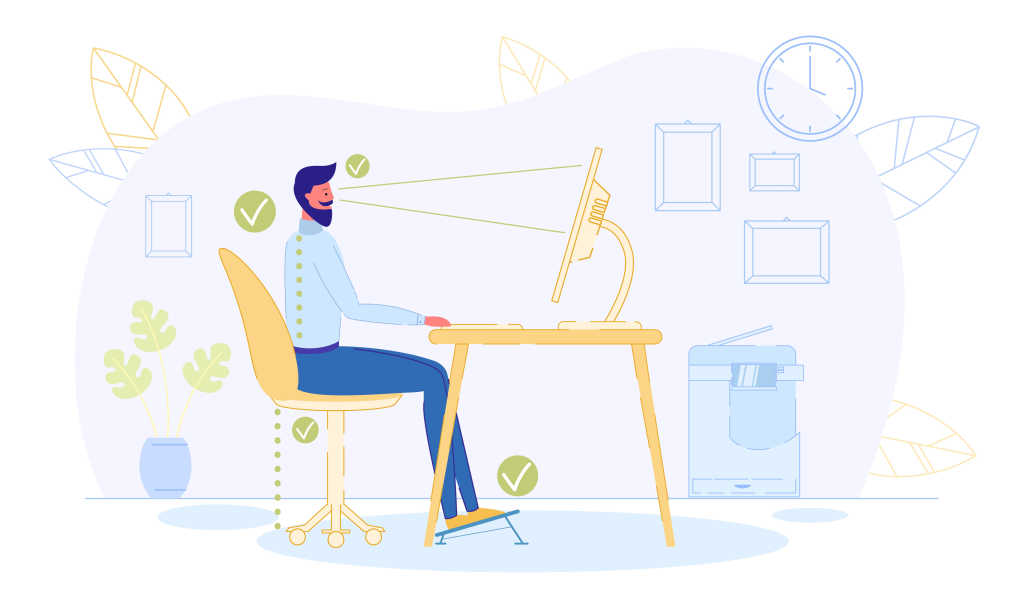5 Ways to Fix Common Ergonomic Issues in Your Home Office
Are you someone who has been negatively affected by the physical challenges of working from home? These tips on how to change your space with objects you have lying around your home are for you!
- Hinge Health Learning Center
- Articles
- 5 Ways to Fix Common Ergonomic Issues in Your Home Office
Our Hinge Health Experts
Chloe Sondler
Over the past year, have you transformed your bedroom into your office? Has your kitchen table become your conference room? To curb COVID-19, many Americans have found themselves working from home. They’ve been forced to transform their living and dining areas into home offices.
For many, this hasn’t been an easy transition. Especially if it meant leaving behind a decked-out ergonomic space. What is an “ergonomic” space, you ask? Ergonomics is the study of people in their working environment. An ergonomic space is a space that is adjusted to fit a worker. Employees left adjustable chairs and desks when they began to work from home. Most employers have not footed the bill for them to transform their home space into work space. Most are without stipends for office furniture, laptop stands, and external keyboards. In fact our Hinge Health Work from Home Survey Report found only 19% of survey respondents said their employer reimbursed them for their home office equipment.
Studies show that satisfaction with one’s work environment can improve job satisfaction and performance. Ergonomically sound workstations also tend to improve productivity. Studies have also found a link between work-from-home setups and increased neck pain and stress. Are you someone who has been negatively affected by the physical challenges of working from home? Or are you trying to prevent this from happening? Either way, these tips on how to change your space with objects you have lying around your home are for you!
Here are 5 ergonomic issues and some easy fixes for you and your employees:
1. Problem: Your laptop or monitor is too low.
Your laptop or computer screen is too low to read comfortably from and you’re feeling neck and shoulder pain.
Helpful Tips:
Prop it up. Aim to have the top of your screen at about eye level. A stack of thick books, reams of paper, or a sturdy box will work.
2. Problem: Your chair is not the right height for you.
Your chair is too high, leaving your feet dangling. Or it’s too low, which makes you feel as though your knees are too high above your hips.
Helpful Tips:
You can remedy the high-seat problem by placing a stack of books, a ream of paper, or a sturdy box or other container under your feet. Rectangular plastic containers tend to work better than cardboard boxes.
To deal with a too-low seat, put 1 or 2 pillows or folded towels or blankets on the seat. This will raise your hips. You may have to play around with the arrangement of objects you choose to feel secure. You can try a combination of towels or blankets if your pillows are too plush for stacking.
3. Problem: You don’t have enough back support in the chair you’re using.
Helpful Tips:
Put a rolled-up towel or pillow behind you at the curve of your back. (Secure the towel roll or pillow with tape if you have difficulty keeping it in the right shape). Start with a small roll and add extra padding if you feel it is necessary.
4. Problem: Your wrists rest in an uncomfortable upward- or downward-facing position.
Helpful Tips:
Use folded or rolled towels underneath your forearms. Lifting your arms will put your wrists in a more neutral position. If it feels like you’re using your muscles to hold up your arms after you make this change, try using an extra layer of support.
5. Problem: You have stiffness in your neck, back, hips, or knees at the end of the workday.
Helpful Tips:
Changing position throughout the day is a great way to help manage joint stiffness. At Hinge Health, we like to say that movement is medicine. Try setting a timer in your phone to remind you to get up every 1 or 2 hours. You can walk a lap in your hallway or bedroom or try one of your Hinge Health exercise playlists. Don’t have a standing desk but want to be able to stand for some of your work? You could try working at your kitchen counter or a tall dresser. If the laptop or screen height doesn’t feel quite right, apply the tips in #1.
It’s important to remember that people are affected in different ways by their work setups. You may find that getting up during the day helps more than physical changes to your space. Changes should be made with a trial-and-error mindset—they can always be reversed or revised. A more comfortable work environment is minutes away with these quick tips. Give them a try!
Hinge Health’s complete clinical model combines 1-on-1 video visits with dedicated physical therapists & health coaches and technology to more effectively reduce chronic back and joint pain at lower spend. To find out how Hinge Health can help your employees address their back and joint pain including prevention, acute injuries, chronic pain, and post-surgery rehab, request a demo below.

